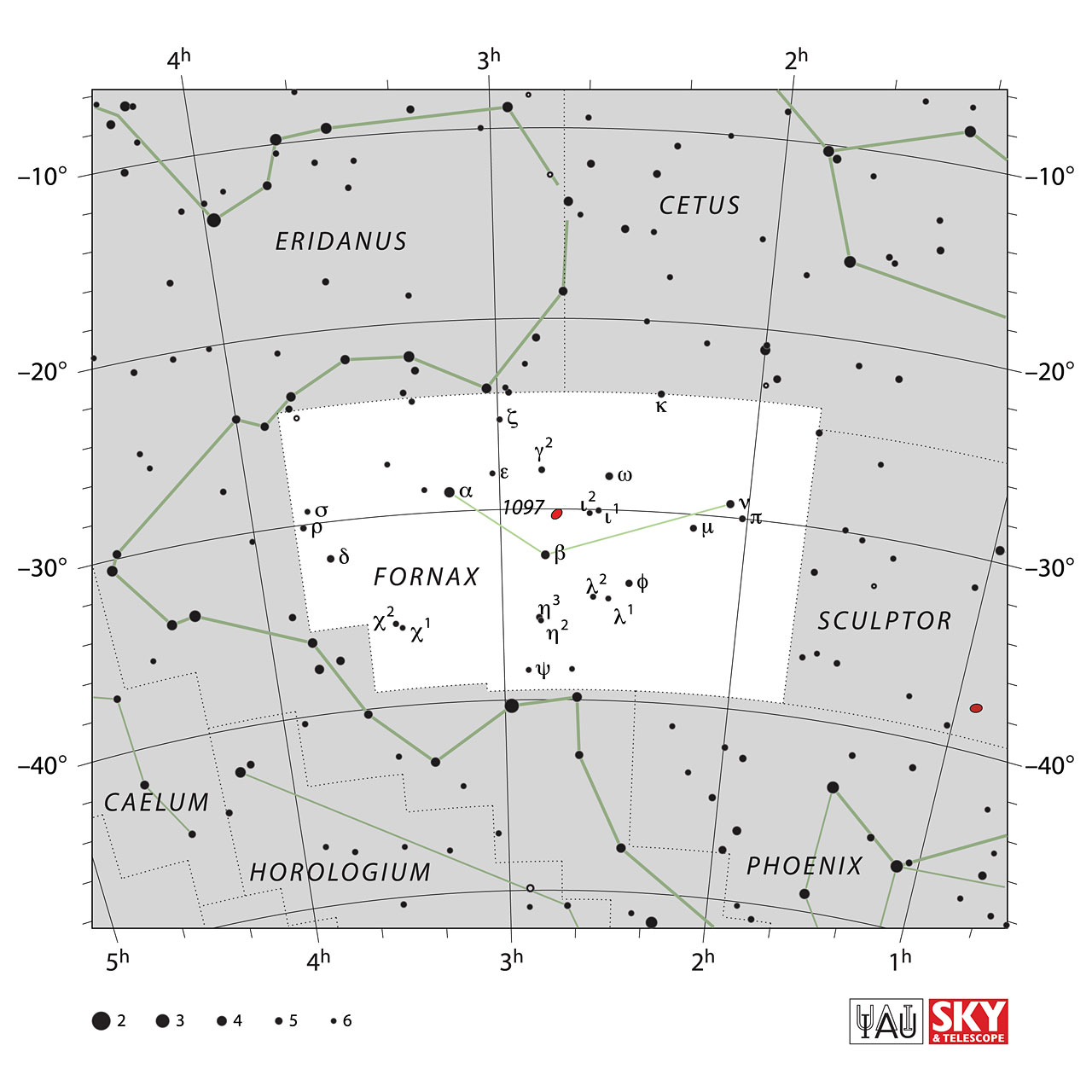Fornax


Fornax is a faint constellation in the southern sky, visible in the evening sky in the months around October.
Its brightest stars are of fourth magnitude, but it is best known for some of its extremely faint deep sky objects.
Lying well away from the plane of the Milky Way, Fornax offers an extremely good window on the distant Universe. Even compared to other similarly dark sky areas, Fornax offers unusually large areas of sky where there is minimal obscuration from nearby material.
For this reason, it was chosen for the Hubble Ultra Deep Field. Other deep sky objects of interest include the Fornax Dwarf galaxy – a nearby companion to the Milky Way – and the Fornax Cluster of galaxies. Both, however, require a large telescope and exceptionally dark skies to be seen.
The name ‘Fornax’ was given to this sky area by Nicolas Louis de Lacaille in 1756. It is Latin for ‘furnace’.
Fornax is called ಅಗ್ನಿಕುಂಡ (Agnikunda) in the Indian constellation naming system.
Fornax contains:
-
Stars
- α-For (mag 3.9)
- β-For (mag 4.5)
- ν-For (mag 4.7)
- ω-For (mag 5.0)
- δ-For (mag 5.0)
- φ-For (mag 5.1)
- κ-For (mag 5.2)
- μ-For (mag 5.3)
- π-For (mag 5.4)
- γ²-For (mag 5.4)
- η³-For (mag 5.5)
- ρ-For (mag 5.5)
- HD 20729 (mag 5.6)
- ζ-For (mag 5.7)
- χ²-For (mag 5.7)
- ι¹-For (mag 5.7)
- λ²-For (mag 5.8)
- ι²-For (mag 5.8)
- ε-For (mag 5.9)
- λ¹-For (mag 5.9)
- σ-For (mag 5.9)
- HD 20606 (mag 5.9)
- η²-For (mag 5.9)
- ψ-For (mag 5.9)
- HD 21430 (mag 5.9)
-
Open Clusters
- None
-
Globular Clusters
- NGC 1049 (mag 13.6)
-
Galaxy
- NGC 1316 (mag 8.5)
- NGC 1097 (mag 9.2)
- NGC 1399 (mag 9.6)
- NGC 1365 (mag 9.6)
- NGC 1398 (mag 9.7)
- NGC 1344 (mag 10.3)
- NGC 1350 (mag 10.5)
- NGC 1326 (mag 10.5)
- NGC 1201 (mag 10.6)
- NGC 1387 (mag 10.7)
- NGC 1379 (mag 10.9)
- NGC 1385 (mag 10.9)
- NGC 1317 (mag 11.0)
- NGC 1374 (mag 11.1)
- NGC 1255 (mag 11.1)
- NGC 1079 (mag 11.4)
- NGC 1302 (mag 11.4)
- NGC 1381 (mag 11.5)
- NGC 1425 (mag 11.6)
- NGC 1310 (mag 12.1)
- NGC 1288 (mag 12.1)
- NGC 922 (mag 12.2)
- IC 1788 (mag 12.4)
- NGC 1375 (mag 12.4)
- NGC 1380 (mag 12.4)
View Fornax in 3D 
Source: Wikipedia, in-the-sky.org
Image Courtesy: Sky&Telescope & IAU, Illustration Images linked from Urania's Mirror on Wikmedia Commons by Sidney Hall
Image Courtesy: Sky&Telescope & IAU, Illustration Images linked from Urania's Mirror on Wikmedia Commons by Sidney Hall
